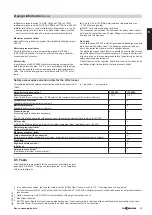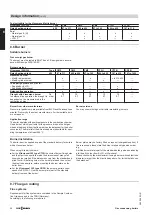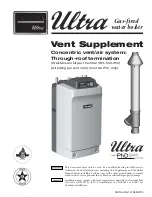
Combustion air inlet through the annular gap (angular)
Rated heating
output range in
kW
System size,
flue system
Min. internal
shaft dimen-
sion
Max. flue height
in m
Vitocrossal 200, type CM2
80 to 87
DN 125
200 x 200
17
80 to 87
DN 150
250 x 250
30
105 to 115
DN 150
250 x 250
30
130 to 142
DN 150
250 x 250
21
130 to 142
DN 200
300 x 300
30
170 to 186
DN 200
300 x 300
25
225 to 311
DN 250
350 x 350
30
Vitocrossal 300, type CT3U
370 to 400
DN 250
350 x 350
24
460 to 500
DN 250
350 x 350
9
460 to 500
DN 250
400 x 400
18
575 to 630
On request
Combustion air inlet through the annular gap (circular)
Rated heating
output range in
kW
System size,
flue system
Min. internal
shaft dimen-
sion
Max. flue height
in m
Vitocrossal 200, type CM2
80 to 87
DN 125
220
17
80 to 87
DN 150
250
30
105 to 115
DN 150
250
26
130 to 142
DN 150
250
15
130 to 142
DN 200
300
30
170 to 186
DN 200
300
17
225 to 311
DN 250
350
21
Vitocrossal 300, type CT3U
370 to 400
DN 250
400
27
460 to 500
DN 250
400
11
575 to 630
On request
The details apply subject to the following assumptions:
■ Length of the connection piece: 2 m and 3 x 87° bends (including
support bends)
■ The flue diameter equals that of the flue system size
■ Diameter of the ventilation air line: DN 150, 200 or 250, max. length
1.5 m
■ Average roughness of the internal shaft wall 1.5 mm
Note
With the Vitocrossal 200 with MatriX radiant burner, a draught of
70 Pa is available for the balanced flue system.
Combustion air inlet through the annular gap:
Prior to installation, the relevant flue gas inspector should check that
the shaft to be used is suitable and approved for this purpose.
Shafts that were previously connected to oil or solid fuel boilers must
be thoroughly cleaned by a chimney sweep. Loose deposits (in par-
ticular sulphur and soot deposits) must not remain on the inside of the
chimney. Running a balanced flue pipe through the shaft is then not
required.
Close off and seal any other connection apertures with appropriate
materials.
This does not apply to any cleaning or inspection apertures that are
provided with chimney cleaning covers and that are identified with an
appropriate test mark.
For vertical roof outlets where the Vitocrossal 200 up to 142 kW
is installed in the attic (type C
53
to TRGI 2008)
Only use the roof outlet if the ceiling of the installation room is also part
of the roof structure. In constructing the roof outlet, maintaining a min-
imum distance to combustible materials is not required.
Secondary ventilation ensures that no temperatures in excess of
85 °C occur on any surface around the roof outlet.
According to TRGI 2008, a minimum distance of 100 mm must be
maintained between the flue pipe (connection piece) and combustible
materials.
Max. extended pipe length 6 m with the max. number of bends
■ 87° 2 pce
■ 45° 2 pce
For a different number of bends, either deduct from or add to the
extended pipe length 1 m for 87° bends or 0.75 m for 45° bends.
Install an inspection port for checking and cleaning the flue pipe inside
the installation room.
Vertical flat roof outlet
Integrate the flat roof collar into the roof skin according to the flat roof
guidelines (see page 43). Insert the roof outlet from above and push
onto the flat roof collar.
Note
■ The ceiling opening should provide a diameter of at least 185 mm.
Secure the roof outlet on site with a clamp after the installation has
been completed.
■ Install the flue system free of load and torque stress.
■ If the flues are longer than 5 m, provide braces on site.
Ventilation air system
If the ventilation air supply is routed separately, use individual com-
ponents in the corresponding system size for flue pipes.
Design information
(cont.)
Gas condensing boilers
VIESMANN
37
5822 449 GB
8
















































